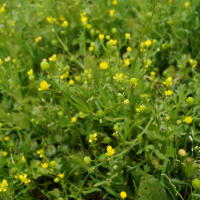Corn buttercup
Ranunculus arvensis
Introduction: Ranunculus arvensis, commonly known as Corn Buttercup or Field Buttercup, is an annual or biennial flowering plant belonging to the Ranunculaceae family. Native to Europe, it has spread to various parts of the world. This plant is often found in agricultural fields, meadows, and disturbed areas, and while it exhibits charming yellow flowers, it is considered a weed in cultivated fields.
Identification:
1. Morphology:
- Height: Corn Buttercup typically grows to a height of 20 to 60 centimeters.
- Leaves: The leaves are lobed and deeply divided, with a basal rosette in the first year.
- Stems: Erect, branching stems covered with fine hairs.
2. Flowers:
- Inflorescence: Bright yellow flowers with five petals, each 1 to 2 centimeters in diameter.
- Blooming Period: Flowers bloom in spring and early summer.
3. Habitat:
- Commonly found in agricultural fields, pastures, meadows, and disturbed areas.
- Prefers well-drained soils and is adaptable to varying moisture conditions.
Ecological Roles:
1. Pollinator Interaction:
- The flowers attract pollinators, including bees and butterflies, contributing to local biodiversity.
2. Soil Stabilization:
- The extensive root system helps stabilize soil, preventing erosion in disturbed areas.
Invasive Characteristics:
1. Weed in Agriculture:
- Corn Buttercup is considered a weed in agricultural settings, where it competes with crops for nutrients, water, and sunlight.
2. Rapid Seed Production:
- The plant produces numerous seeds, and its ability to self-seed contributes to its persistence and spread.
3. Allelopathy:
- Corn Buttercup may release allelopathic chemicals that inhibit the growth of other plants in its vicinity.
Control and Management:
1. Cultural Practices:
- Crop rotation and maintaining good agricultural practices can help manage Corn Buttercup in cultivated fields.
2. Herbicide Use:
- Selective herbicides targeting broadleaf weeds can be employed for control in agricultural settings.
- Herbicides need to be applied according to recommended guidelines to avoid damage to crops.
3. Mechanical Control:
- Mowing or cutting the plants before they set seeds can help prevent further spread.
4. Integrated Weed Management:
- Combining cultural practices, herbicide use, and mechanical control as part of an integrated weed management strategy.









